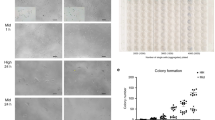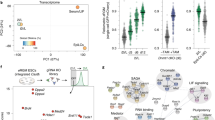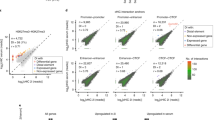Abstract
Epigenetic genome modifications are thought to be important for specifying the lineage and developmental stage of cells within a multicellular organism. Here, we show that the epigenetic profile of pluripotent embryonic stem cells (ES) is distinct from that of embryonic carcinoma cells, haematopoietic stem cells (HSC) and their differentiated progeny. Silent, lineage-specific genes replicated earlier in pluripotent cells than in tissue-specific stem cells or differentiated cells and had unexpectedly high levels of acetylated H3K9 and methylated H3K4. Unusually, in ES cells these markers of open chromatin were also combined with H3K27 trimethylation at some non-expressed genes. Thus, pluripotency of ES cells is characterized by a specific epigenetic profile where lineage-specific genes may be accessible but, if so, carry repressive H3K27 trimethylation modifications. H3K27 methylation is functionally important for preventing expression of these genes in ES cells as premature expression occurs in embryonic ectoderm development (Eed)-deficient ES cells. Our data suggest that lineage-specific genes are primed for expression in ES cells but are held in check by opposing chromatin modifications.
This is a preview of subscription content, access via your institution
Access options
Subscribe to this journal
Receive 12 print issues and online access
$209.00 per year
only $17.42 per issue
Buy this article
- Purchase on Springer Link
- Instant access to full article PDF
Prices may be subject to local taxes which are calculated during checkout





Similar content being viewed by others
References
Terskikh, A. V. et al. From hematopoiesis to neuropoiesis: evidence of overlapping genetic programs. Proc. Natl Acad. Sci. USA 98, 7934–7939 (2001).
Ivanova, N. B. et al. A stem cell molecular signature. Science 298, 601–604 (2002).
Ramalho-Santos, M., Yoon, S., Matsuzaki, Y., Mulligan, R. C. & Melton, D. A. “Stemness”: transcriptional profiling of embryonic and adult stem cells. Science 298, 597–600 (2002).
Fortunel, N. O. et al. Comment on “'Stemness': transcriptional profiling of embryonic and adult stem cells” and “a stem cell molecular signature”. Science 302, 393 (2003).
Evsikov, A. V. & Solter, D. Comment on “'Stemness': transcriptional profiling of embryonic and adult stem cells” and “a stem cell molecular signature”. Science 302, 393 (2003).
Vogel, G. Stem cells. 'Stemness' genes still elusive. Science 302, 371 (2003).
Bernstein, B. E. et al. Genomic maps and comparative analysis of histone modifications in human and mouse. Cell 120, 169–181 (2005).
Schubeler, D. et al. The histone modification pattern of active genes revealed through genome-wide chromatin analysis of a higher eukaryote. Genes Dev. 18, 1263–1271 (2004).
Woodfine, K. et al. Replication timing of the human genome. Hum. Mol. Genet. 13, 191–202 (2004).
Perry, P. et al. A dynamic switch in the replication timing of key regulator genes in embryonic stem cells upon neural induction. Cell Cycle 3, 1645–1650 (2004).
Hiratani, I., Leskovar, A. & Gilbert, D. M. Differentiation-induced replication-timing changes are restricted to AT-rich/long interspersed nuclear element (LINE)-rich isochores. Proc. Natl Acad. Sci. USA 101, 16861–16866 (2004).
Gilbert, N. et al. Chromatin architecture of the human genome: gene-rich domains are enriched in open chromatin fibers. Cell 118, 555–566 (2004).
Rugg-Gunn, P. J., Ferguson-Smith, A. C. & Pedersen, R. A. Epigenetic status of human embryonic stem cells. Nature Genet. 37, 585–587 (2005).
Evans, M. & Hunter, S. Source and nature of embryonic stem cells. C. R. Biol. 325, 1003–1007 (2002).
Schubeler, D. et al. Genome-wide DNA replication profile for Drosophila melanogaster: a link between transcription and replication timing. Nature Genet. 32, 438–442 (2002).
Azuara, V. et al. Heritable gene silencing in lymphocytes delays chromatid resolution without affecting the timing of DNA replication. Nature Cell Biol. 5, 668–674 (2003).
Gilbert, D. M. In search of the holy replicator. Nature Rev. Mol. Cell Biol. 5, 848–855 (2004).
Spooncer, E., Heyworth, C. M., Dunn, A. & Dexter, T. M. Self-renewal and differentiation of interleukin-3-dependent multipotent stem cells are modulated by stromal cells and serum factors. Differentiation 31, 111–118 (1986).
Nutt, S. L., Heavey, B., Rolink, A. G. & Busslinger, M. Commitment to the B-lymphoid lineage depends on the transcription factor Pax5. Nature 401, 556–562 (1999).
Chambers, I. & Smith, A. Self-renewal of teratocarcinoma and embryonic stem cells. Oncogene 23, 7150–7160 (2004).
Hogan, B. L., Taylor, A. & Adamson, E. Cell interactions modulate embryonal carcinoma cell differentiation into parietal or visceral endoderm. Nature 291, 235–237 (1981).
Jones-Villeneuve, E. M., Rudnicki, M. A., Harris, J. F. & McBurney, M. W. Retinoic acid-induced neural differentiation of embryonal carcinoma cells. Mol. Cell Biol. 3, 2271–2279 (1983).
Williams, R. R. et al. Neural induction promotes large-scale chromatin reorganisation of the Mash1 locus. J. Cell Sci. 119, 132–140 (2006).
Montgomery, N. D. et al. The murine polycomb group protein Eed is required for global histone H3 lysine-27 methylation. Curr. Biol. 15, 942–947 (2005).
Peters, A. H. & Schubeler, D. Methylation of histones: playing memory with DNA. Curr. Opin. Cell Biol. 17, 230–238 (2005).
Morin-Kensicki, E. M., Faust, C., LaMantia, C. & Magnuson, T. Cell and tissue requirements for the gene eed during mouse gastrulation and organogenesis. Genesis 31, 142–146 (2001).
Faust, C., Lawson, K. A., Schork, N. J., Thiel, B. & Magnuson, T. The Polycomb-group gene eed is required for normal morphogenetic movements during gastrulation in the mouse embryo. Development 125, 4495–4506 (1998).
Silva, J. et al. Establishment of histone H3 methylation on the inactive X chromosome requires transient recruitment of Eed—Enx1 polycomb group complexes. Dev. Cell 4, 481–495 (2003).
Plath, K. et al. Role of histone H3 lysine 27 methylation in X inactivation. Science 300, 131–135 (2003).
Vogelauer, M., Rubbi, L., Lucas, I., Brewer, B. J. & Grunstein, M. Histone acetylation regulates the time of replication origin firing. Mol. Cell 10, 1223–1233 (2002).
Lin, C. M., Fu, H., Martinovsky, M., Bouhassira, E. & Aladjem, M. I. Dynamic alterations of replication timing in mammalian cells. Curr. Biol. 13, 1019–1028 (2003).
Zhang, J., Xu, F., Hashimshony, T., Keshet, I. & Cedar, H. Establishment of transcriptional competence in early and late S phase. Nature 420, 198–202 (2002).
Ballas, N. & Mandel, G. The many faces of REST oversee epigenetic programming of neuronal genes. Curr. Opin. Neurobiol. 15, 500–506 (2005).
Hansen, R. S., Canfield, T. K., Lamb, M. M., Gartler, S. M. & Laird, C. D. Association of fragile X syndrome with delayed replication of the FMR1 gene. Cell 73, 1403–1409 (1993).
Gomez, M. & Brockdorff, N. Heterochromatin on the inactive X chromosome delays replication timing without affecting origin usage. Proc. Natl Acad. Sci. USA 101, 6923–6928 (2004).
Wang, J. et al. Imprinted X inactivation maintained by a mouse Polycomb group gene. Nature Genet. 28, 371–375 (2001).
Vandesompele, J. et al. Accurate normalization of real-time quantitative RT—PCR data by geometric averaging of multiple internal control genes. Genome Biol. 3, DOI: 10.1186/gb-2002-3-7-research0034 (2002).
Acknowledgements
We thank A. Smith for ES cell lines, M. Dexter for the FDCP-mix A4 clone, M. Busslinger for Pax5-deficient pro-B cells, R. Lovell-Badge for the F9-EC line and V. Episkopou for the embryonic carcinoma cell lines F9 and P19. E. O'Connor, R. Brough, G. Reed and R. Newton are thanked for help and advice and A. Allen, M. Harrison, T. Reed and Z. Szarka (at Oxford Gene Technology, Oxford, UK). J. Santos and S. Giadrossi for communicating unpublished information. S. Giadrossi, N. Brockdorff and M. Raff are acknowledged for advice and critical reading of the manuscript. This work was supported by the Medical Research Council (MRC) and by a MRC Collaborative Career Development Fellowship in Stem Cell Research funded by the Parkinson's disease Society (V.A.).
Author information
Authors and Affiliations
Corresponding authors
Ethics declarations
Competing interests
The authors declare no competing financial interests.
Supplementary information
Supplementary Information
Supplementary Figures S1, S2, S3, S4 and Supplementary Methods (PDF 375 kb)
Rights and permissions
About this article
Cite this article
Azuara, V., Perry, P., Sauer, S. et al. Chromatin signatures of pluripotent cell lines. Nat Cell Biol 8, 532–538 (2006). https://doi.org/10.1038/ncb1403
Received:
Accepted:
Published:
Issue Date:
DOI: https://doi.org/10.1038/ncb1403
This article is cited by
-
A low-input high resolution sequential chromatin immunoprecipitation method captures genome-wide dynamics of bivalent chromatin
Epigenetics & Chromatin (2024)
-
Distinct chromatin signatures in the Arabidopsis male gametophyte
Nature Genetics (2023)
-
The double-edged sword of bivalency
Nature Reviews Molecular Cell Biology (2023)
-
A genome-wide relay of signalling-responsive enhancers drives hematopoietic specification
Nature Communications (2023)
-
Regulation, functions and transmission of bivalent chromatin during mammalian development
Nature Reviews Molecular Cell Biology (2023)



